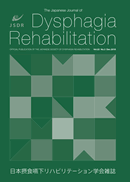Volume 3, Issue 1
The Japanese Journal of Dysphagia Rehabilitation
Displaying 1-8 of 8 articles from this issue
- |<
- <
- 1
- >
- >|
Original Paper
-
1999 Volume 3 Issue 1 Pages 3-9
Published: June 30, 1999
Released on J-STAGE: June 06, 2019
Download PDF (2897K) -
1999 Volume 3 Issue 1 Pages 10-20
Published: June 30, 1999
Released on J-STAGE: June 06, 2019
Download PDF (5136K) -
1999 Volume 3 Issue 1 Pages 21-28
Published: June 30, 1999
Released on J-STAGE: June 06, 2019
Download PDF (3627K) -
1999 Volume 3 Issue 1 Pages 29-33
Published: June 30, 1999
Released on J-STAGE: June 06, 2019
Download PDF (2080K) -
New test materials produced with iopamidol and agar for videofluorography in patients with dysphagia1999 Volume 3 Issue 1 Pages 34-39
Published: June 30, 1999
Released on J-STAGE: June 06, 2019
Download PDF (2503K)
Clinical Report
-
1999 Volume 3 Issue 1 Pages 40-44
Published: June 30, 1999
Released on J-STAGE: June 06, 2019
Download PDF (2110K) -
1999 Volume 3 Issue 1 Pages 45-47
Published: June 30, 1999
Released on J-STAGE: June 06, 2019
Download PDF (1319K)
Clinical Hint
-
1999 Volume 3 Issue 1 Pages 48-49
Published: June 30, 1999
Released on J-STAGE: June 06, 2019
Download PDF (778K)
- |<
- <
- 1
- >
- >|
